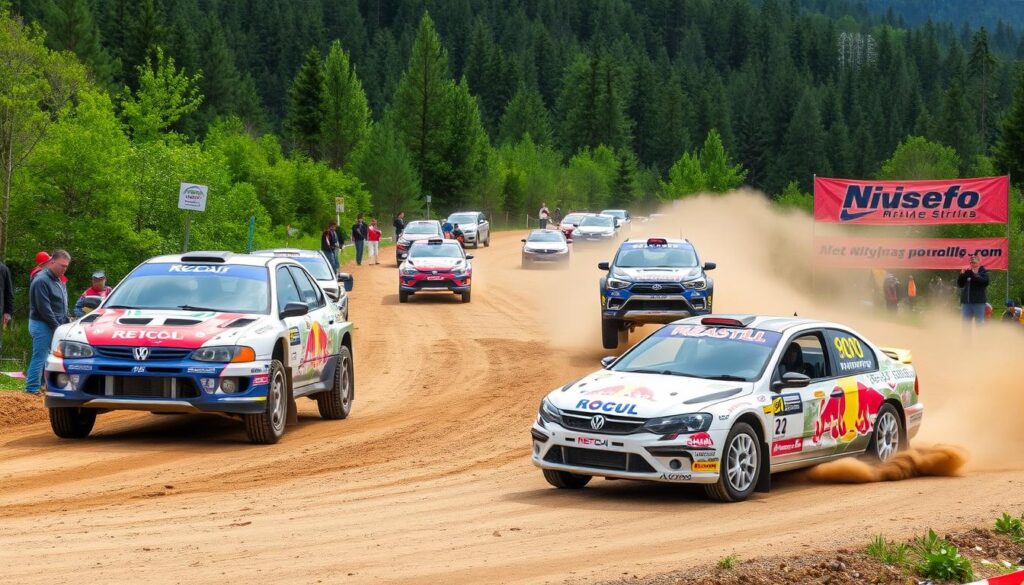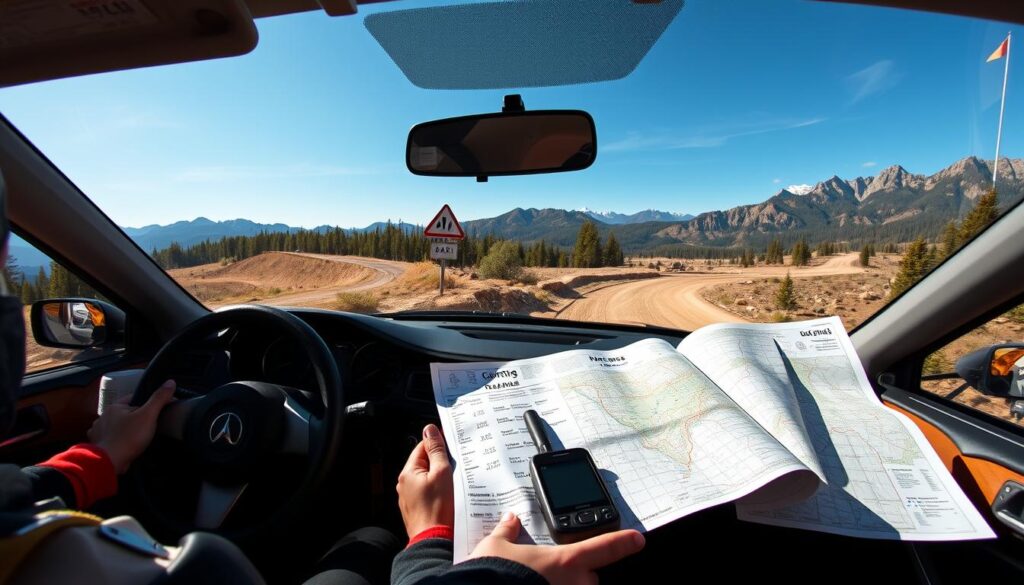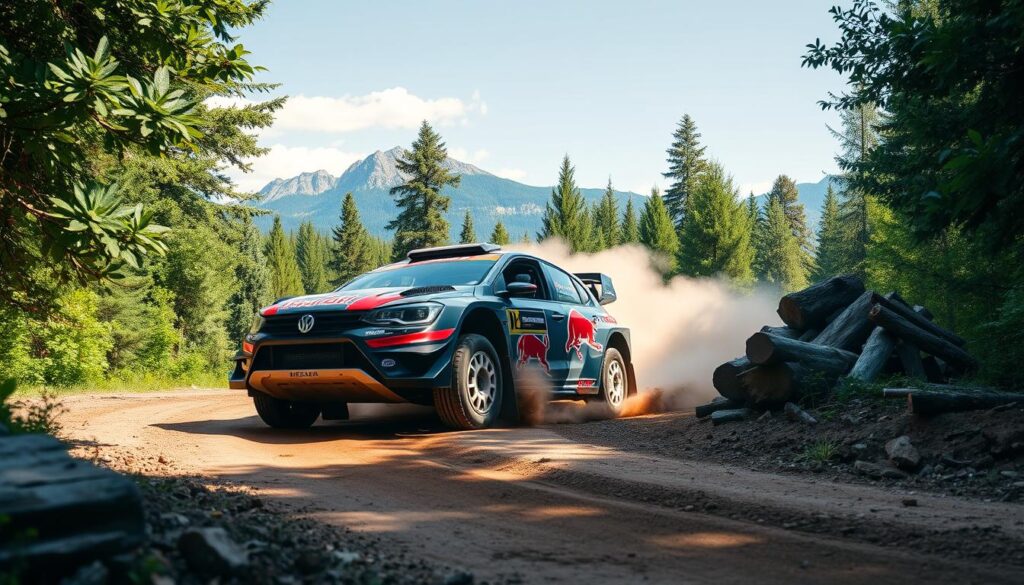Ever been drawn to the thrill of rally racing? It’s a world where tires cling to dirt and gravel. Drivers test their limits and skills on tough off-road tracks. If you dream of joining this world, you’re not alone.
Today, we’ll take a journey together. We’ll explore the key steps to becoming a top rally driver.
In This Guide
Understanding Rally Racing Fundamentals
Rally racing is an exciting motorsport that tests drivers’ skills and endurance. To succeed, knowing the basics and event types is key. Whether you aim for rally racing licenses or want to join a rally driving school, grasping rally racing’s fundamentals is crucial.
Different Types of Rally Events
Rally racing includes various event formats, each with its own challenges. The main types are stage rallies and cross-country rallies:
- Stage rallies are timed, closed-road events where drivers aim for the fastest time on different terrains.
- Cross-country rallies, or rally-raids, cover open roads and off-road tracks over long distances, often across days.
Basic Rally Racing Rules and Regulations
Rally racing has strict rules for safety and fairness. Key rules include:
- Speed limits are enforced on all stages and public roads.
- Drivers must wear safety gear like helmets and harnesses.
- Service and refueling follow strict procedures at designated areas.
- Drivers must follow route instructions and pace notes for navigation.
Essential Rally Racing Terminology
Knowing rally racing’s specialized terms is vital. Key terms include:
| Term | Definition |
|---|---|
| Special Stage | A timed, closed-road section where drivers aim for the fastest time. |
| Liaison | The public road sections connecting special stages, where drivers must follow speed limits. |
| Pace Notes | Notes that guide the driver through the special stage, detailing road and driving conditions. |
| Recce | A reconnaissance run before the timed event, helping drivers and co-drivers familiarize with the course. |
Grasping these rally racing basics is the first step to becoming a skilled driver.
Required Skills and Physical Preparation
To be a top rally driver, you need special skills and physical traits. You must have talent, determination, and know the technical and mental sides of the sport well.
The key rally driver skills include fast reflexes, great car control, and the ability to handle tough terrain at high speeds. Knowing how to control the car, like advanced braking and managing weight, is also vital for rally courses.
Being physically fit is also key. Rally racing is tough, both physically and mentally. Drivers need endurance, strength, and agility. They must stay focused and react quickly during long, intense drives.
- Developing superior rally car control skills, including precise steering, braking, and throttle management
- Enhancing reflexes and hand-eye coordination through targeted training and practice
- Building cardiovascular endurance and muscular strength to withstand the physical demands of rally driving
- Cultivating mental toughness and the ability to maintain focus and composure under pressure
By improving these skills and physical traits, aspiring rally drivers can succeed on rally courses. Becoming a rally driving champion takes hard work, discipline, and a love for the sport.
| Key Rally Driver Skills | Physical Preparation Essentials |
|---|---|
|
|
How to Become Rally Driver: Getting Started
Starting your journey to become a rally driver is both exciting and challenging. You’ll need to meet certain training needs, find a mentor, and connect with the rally community.
Initial Training Requirements
To begin, you must get the right licenses and complete basic rally driving training. This means getting a driver’s license, finishing a rally driving school, and possibly getting special rally driving licenses or certifications.
Finding a Mentor or Coach
Finding an experienced rally driver to mentor you is key. They can teach you the technical skills, share their knowledge, and guide you through the competition. Look for a reputable rally driving school to find a good coach.
Building Your Support Network
Having a strong support network is essential. Connect with rally fans, join clubs, and meet mechanics, engineers, and logistics experts. A good network offers advice, resources, and friendship as you grow in the sport.
| Initial Training Requirements | Mentor or Coach | Support Network |
|---|---|---|
|
|
|
By meeting the initial training needs, finding a mentor, and building a network, you’re set for success. With hard work and a love for rally driving, you’re ready for an exciting journey.
Choosing the Right Rally Driving School
Choosing the right driving school is key to improving your rally driving skills. With many options, it’s important to look at the curriculum, instructor skills, and resources. This ensures you get top-notch training.
The curriculum is a big factor. Look for a program that covers the basics of rally racing. This includes car control, navigation, and safety. A well-rounded curriculum prepares you for rally car racing.
It’s also crucial to check the instructors’ experience and qualifications. Choose a school with experienced rally drivers. They can share valuable insights and guide you. Make sure the instructor-to-student ratio is good for personalized attention.
Lastly, check the school’s equipment and facilities. A good school should have various vehicles and access to rally stages or off-road areas. These resources help you practice and improve your skills safely.
| Key Factors to Consider | Description |
|---|---|
| Curriculum | Comprehensive coverage of rally racing fundamentals, including car control, navigation, and safety |
| Instructor Expertise | Seasoned rally drivers with a proven track record of training successful competitors |
| Equipment and Facilities | Access to a variety of rally cars and purpose-built training areas or stages |
By evaluating these factors, you can find a rally driving school that meets your needs. It will provide the skills and resources for success in rally car racing.

Essential Rally Car Control Techniques
Mastering rally car control is key for success in off-road racing. Drivers need to know advanced braking and how to manage weight transfer. These skills help them tackle tough terrains and tight corners.
Advanced Braking Methods
Left-foot braking is a crucial technique in rally car control. It helps drivers control the car’s weight better, making turns sharper and quicker. By braking with the left foot and controlling the throttle with the right, drivers improve their braking and control.
Corner Entry and Exit Strategies
Cornering is a skill rally drivers must master. The Scandinavian flick is a key technique. It involves a controlled oversteer at the turn’s start, setting up for a better exit. This method uses the car’s weight and suspension to control speed and maintain control through corners.
Weight Transfer Management
- Managing weight transfer is vital for rally car control. It affects the car’s stability and traction.
- Drivers need to understand how weight shifts during driving. This lets them adjust their style for better performance and control.
- Techniques like trail braking and throttle modulation help manage weight transfer. This improves lap times and makes racing safer and more confident.
Learning these rally car control techniques is essential for success. Whether you’re new or experienced, improving these skills will enhance your off-road racing. It will take your performance to new heights.
Mastering Rally Navigation and Pace Notes
In the world of rally racing, knowing how to navigate and read pace notes is key. Rally navigation techniques are what make champions. They help drivers and co-pilots get ready for challenges and adjust to changing road conditions quickly.
The driver and co-driver work together closely. The co-driver gives detailed info about what’s coming up, like corners and obstacles. This helps the driver make quick decisions and keep the car in control.
- Making Good Pace Notes: The first step is to make detailed pace notes. These notes are like a map, showing all the turns and obstacles. They help the co-driver tell the driver what to do next.
- Understanding Pace Notes: It’s important to know the course well and understand the pace notes. This skill takes time and practice. You need to be very detail-oriented.
- Working Well Together: A good rally team needs to work together smoothly. Trust, clear communication, and knowing the course well are key to success.
Starting your rally driving journey? Remember, rally navigation techniques are crucial. Spend time improving your pace note skills and building a strong team with your co-driver. With hard work and practice, you’ll get better at navigating and aim for the top.

“The key to winning in rally racing is to master the art of navigation. The driver and co-driver must work in perfect harmony to anticipate and respond to the ever-changing terrain.”
Building Your Rally Racing Career Path
Starting a career in rally car racing is thrilling, with both hurdles and chances. You might aim for local rallies or the top of professional racing. There are important steps to follow for a successful career.
Amateur Competition Opportunities
Begin by joining local and regional amateur races. These events are great for improving your skills and building your reputation. Look for rallies and events in your area, often run by local clubs or governing bodies.
Professional Development Strategies
- Find mentors among seasoned rally drivers for advice and insights.
- Go to rally schools and workshops to sharpen your skills.
- Connect with rally fans, team owners, and industry pros to find new chances.
Sponsorship and Funding Options
Finding sponsors and funding is key for a rally racing career. Talk to local businesses, motorsports brands, and investors who might support you. Make a strong proposal that highlights your talent, hard work, and what they can gain.
| Sponsorship Opportunities | Funding Sources |
|---|---|
| Vehicle branding | Crowdfunding campaigns |
| Team apparel and equipment | Motorsports-focused grants and scholarships |
| Event and race weekend hospitality | Personal savings and investments |
By using these tactics, you can move up in rally driving championships and rally car racing. This way, you can achieve your goal of becoming a top rally driver.
Safety Equipment and Vehicle Requirements
Getting into rally car racing or off-road racing means you need to focus on safety. As a new rally driver, knowing the safety gear and car specs is key. This keeps you safe and your car in top shape during races.
First, getting the right safety gear is essential. You’ll need a certified helmet, a fire-resistant suit, gloves, and special racing shoes. These protect you in crashes and help you stay in control and comfortable. Your car also needs a roll cage, seatbelts, and a fire extinguisher for extra safety.
Also, your car must meet strict rules on engine and suspension changes. These tweaks improve your car’s speed and handling on tough rally tracks. Following these rules shows you’re serious about racing safely and responsibly.


Pingback: How to become a WRC driver 13 tips